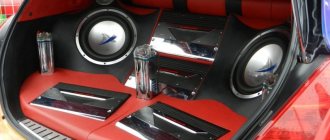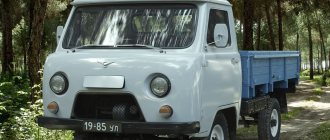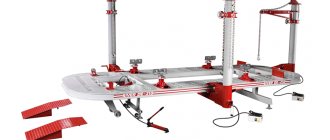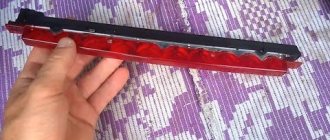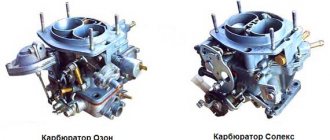Experienced motorists can give thousands of examples when mud, ice or deep snow prevent the successful completion of a trip. The power of the driving wheels is powerless in such situations - only a tug or a winch. After such unpleasant moments, some owners refuse to travel in bad weather, while others decide studded tires. However, there is another category of drivers who prefer to independently manufacture additional equipment to increase cross-country ability.
Design features of homemade chains for car wheels
The basic design is a simple structure that consists of a set of steel links or reinforced wire. Uniform distribution of components over the entire tire area is the key to successful operation of the product.
Classic DIY snow chains in the video look like two elements that are located longitudinally along the radius of the wheel on the outer and inner sides. They are connected to each other by transverse parts, the so-called lugs. The manufacturing method is not difficult even for novice motorists. The arrangement of parts is carried out according to three schemes:
- Diamonds.
- Ladder.
- Honeycombs.
Each of the above types has its own disadvantages and advantages. The first option with a “ladder” is the most affordable in financial terms, as well as in terms of labor costs. No less interesting is the solution with bracelets, which are also convenient when installed on a wheel.
Types of anti-slip chains by type of material
Anti-slip equipment of various types ; it is also possible to make wheel chains with your own hands. They differ in the types of materials and in the characteristic pattern of the chains themselves.
Soft chains
Soft wheel chains are made of rubber, polyurethane and other plastics . They are a mesh with metal spikes along the entire perimeter.
The most popular soft anti-slip chains are made from polyurethane . They are highly resistant to wear and tear, very elastic and resistant to chemicals.
Rubber is much inferior in properties to polyurethane.
They are quite expensive , but they can be used in urban environments without damaging the road . In addition, the speed when driving with such chains on wheels can be kept quite high - up to 80 km/h . Such devices are not effective for severe off-road conditions and icy conditions .
Hard chains
This type of chain is made from hard materials - steel, aluminum or titanium. They are inexpensive, but very reliable. Ideal even for heavy ice and off-road conditions. With classic chain devices, it is not recommended to drive faster than 50 km/h.
Anti-skid bracelets
Such equipment is distinguished by the absence of longitudinal elements . The bracelets are attached across the entire circumference of the wheel at the same distance. Easy to install, but less effective off-road.
Bracelets, photo
What is needed to make homemade car snow chains for wheels?
The inability to purchase factory-made devices that increase cross-country ability, as well as their high price, push car enthusiasts to solve the problem on their own. It should be noted that this is a completely reasonable choice - the necessary components can be found in any hardware store, and every self-respecting driver has a minimum set of tools.
It should be said that information on how to make snow chains with your own hands and videos include a list of design elements. Let's focus on the simplest model, made according to the “ladder” scheme. To implement it you will need:
- chain with a cross section of at least 5 mm made of steel;
- carabiners with a threaded coupling;
- tension mechanism;
- washers, bolts and nuts;
- hooks, carbines.
On average, about 15 meters of chain ; more accurate figures will be known only after specific measurements. It is recommended to use stainless metal hardware as chains. The preparatory process ends with the collection of tools:
- Bulgarian;
- vice;
- hammer;
- set of wrenches.
What are the dangers of using snow chains?
With the constant use of snow chains, the following negative consequences :
- The load on the steering device increases.
- The suspension wears out quickly.
- The chains make a lot of noise when driving.
- Tire wear increases.
- Unable to maintain high speed.
- It's not comfortable to move around.
Do not use these rigid devices when driving on asphalt roads - this will damage the road surface.
Observe the speed limit : for hard ones - no higher than 80 km/h, for soft ones - no more than 50 km/h. Use such equipment only in emergency situations to increase maneuverability.
Homemade hooks (mordovkas, anti-skid belts, anti-slip tapes) are suitable for any car - Gazelle, truck, tractor, UAZ, VAZ, Niva and others.
We study the process: how to make snow chains for cars with your own hands and video of working moments
Experienced motorists assure that at critical moments a cable or even simple rigging comes to the rescue. You can simply wrap them around a wheel, another question is that such things are not always at hand. Moreover, this method is strictly contraindicated for cars equipped with a disc brake system. Therefore, it is better to be patient in advance and make a “chain body kit” yourself.
When making snow chains with your own hands using available videos, where the footage of the blanks is not always indicated, it is important to make accurate measurements of the radius and width of the tire. Based on the results obtained, calculate the parameters of the future product. The number of transverse elements ( lugs ) is also selected individually for each car model. Experts recommend focusing on the fact that there should be two transverse parts at once in the plane of the contact patch of the coated rubber.
The procedure for assembling a device to increase cross-country ability consists of performing the following points:
- cut longitudinal and transverse chain blanks with a grinder;
- secure the first transverse element to the 6th link of the longitudinal part using bolts and washers, hooks or welding;
- mount all subsequent crossbars every 8-9 links;
- in the center of one longitudinal element, install a segment consisting of 6-8 links and a tension device to securely fix the product;
- Install carabiners with a diameter of at least 5 mm at the ends of the longitudinal sections.
If you have certain skills and tools, the operation will take about 40-60 minutes. It will be useful to have experience in welding work, which will allow you to avoid threaded connections in practice, which will have a positive effect on the quality of the device.
Types of anti-slip chains according to the picture
Depending on the weaving pattern of the chain links, there are several types of devices. Their properties differ , so be careful when choosing.
Ladder
These are two circles of chains connected to each other by transverse segments . They got this name because from the outside these devices are very similar to a ladder.
This is the most inexpensive and easiest to manufacture option for snow chains. They also have some disadvantages :
- less effective when driving on snowdrifts and dirt ;
- the car moves in jerks , and this overloads the transmission;
- the car is thrown to the sides across the traffic.
Rhombus
In such devices, circles from chains are connected by segments not in a straight line, but diagonally crosswise. This produces a characteristic diamond-shaped pattern.
These anti-slip chains are ideal for driving in wetlands or deep snow . They are very durable and provide good grip .
Perfect for SUVs and off-road vehicles . They increase the vehicle's many times over
They are deprived of almost all the disadvantages of their “ladder” counterparts.
Honeycomb
This pattern is obtained by connecting hexagons from chains together at the corners. There are hexagons in the center, and pentagons at the edges. Such devices have all the advantages of diamond-shaped ones , plus they add even greater lateral stability .
Photo of chains according to the drawing
This is interesting: Sign “No stopping without stopping” - 2.5 Traffic Rules of the Russian Federation
Details: which locks on homemade snow chains are better and why?
When making traction control devices in garage conditions, drivers most often use the following types of locking mechanisms to secure them to the tire:
- S-shaped;
- hook-shaped;
- with ratchet mechanism.
Some homemade wheel chains are equipped with an S-shaped lock structure, which is locked with a four- or hex key. However, many complain about unreliable fixation and lack of adjustments for this option. In addition, installing such equipment is a complete inconvenience.
The second option for fixing the chain device is more common and holds quite well. If the chain is correctly laid, fastening can be done with a screwdriver without any problems. For a complete guarantee, car enthusiasts advise tying the contact point with 1-3 mm soft wire. Disassembly of the equipment also occurs quickly without much effort.
The ratchet lock model was previously used on trucks. It is characterized by high reliability and ease of operation. The sample provides fixation without the use of additional materials.
Varieties of lugs according to geometric pattern
Depending on the geometry of the pattern, there are three types of snow chains:
- "Ladder".
- "Rhombus".
- "Honeycombs".
Each option has its own advantages and disadvantages, so we will consider them in detail.
"Ladder"
The “ladder” is a base in the form of longitudinally arranged branches. These branches are evenly distributed around the entire circumference of the wheel. To secure the chain on the wheel, the appropriate type of locks are used. Externally, this type of lug resembles a ladder, which is where the name comes from.
This lug option is one of the most popular, effective and in demand. Among the disadvantages of this type of chain it is worth noting:
- parallel arrangement of chains on the wheel, so the car will dig in when overcoming snowy or soil areas;
- low lateral stability, which is also due to the parallel arrangement of the chain branches;
- heavy load on the transmission.
Despite the high raking properties, ladder-type chains are practically useless on snowy ground
It is recommended to use chains of this type only when it is necessary to overcome a risky section of the route. This option is one of the cheapest, so when the need arises, most drivers prefer this option without delving into its features.
"Rhombus"
The diamond lug design is a modernized "Ladder" design. For this purpose, there are longitudinal branches that form a diamond-shaped pattern, eliminating all the negative factors that are characteristic of the “Ladder”.
The geometric shape in the form of a diamond is intended for the use of lugs when it is necessary to overcome a snowy or swampy area. The diamond shape is shown in the photo below.
Diamond-shaped chains have increased strength and high traction characteristics
The diamond-shaped shape of snow chains is popular among SUVs and crossovers, since this type of pattern on the lug increases the vehicle's cross-country ability several times. This is especially true for snow-covered and icy road sections.
"Honeycomb"
An analogue of a rhombus are “honeycombs”, which have transverse branches similar to a rhombus, but are additionally connected by straight connectors. Diamond and honeycomb are improved types of lugs, in which the products are in constant contact with the road surface. This is a big plus for both rubber and transmission, so when making lugs it is recommended to pay attention to the last two models.
“Honeycombs” ensure constant contact with the road, therefore giving the car a high level of lateral stability
It is also worth noting that when purchasing snow chains, you need to consider their size. The lugs produced in production are divided not only by size for wheels, but also depending on the type of car.
How to install snow chains on a car with your own hands and video operation
Experts recommend installing traction control equipment on all wheels, and not just on the drive ones. Incorrect installation can lead to damage to ABS sensors, brake system components and wheel arch liners, as well as side tire cuts . On SUVs with a plug-in second axle, the device is installed primarily on the pair that is constantly in operation. The installation operation is performed in two ways:
- With jacking.
- On a stationary car.
The essence of the question is not only how to properly make snow chains on a car with your own hands using a video - you should think about installation work even before entering the problem area. This is the only way to enjoy the operation, save your time and avoid annoying mistakes.
There is no point in describing the first method using a jack - the procedure is elementary and will not cause any difficulties even for a novice driver. The only recommendation is to reduce the tire pressure to make the work easier.
Another question is when this device is not at hand. In this case, you can install chains on snow wheels with your own hands using the following technology:
- place the product in front of the wheel pair, avoiding twisting of the links;
- run over the product with wheels;
- apply the handbrake;
- put on the device so that the hook and carabiner are on the outside of the wheel;
- connect the hook and the last link of the longitudinal part to the inside of the wheel;
- put the carabiner coupling on the tension system from the outside and fix the knot;
- distribute the transverse elements along the entire perimeter of the tire and tighten it.
Important! To ensure uniform distribution of equipment components, drive 20-30 meters and then make final adjustments. This event will guarantee maximum adherence of the product to the rubber.
Varieties and how they differ
Many drivers, having become familiar with the disadvantages of lugs, make a negative decision about purchasing or manufacturing them. However, sooner or later a situation comes when the presence of chains will not hurt. Grunts are divided into several types. The main distinguishing parameters are: the material of manufacture and the geometric pattern of the chain product on the tire.
Depending on the material of manufacture, lugs are divided into the following types:
- Tough.
- Soft.
Rigid lugs
Rigid types include products made from the following types of metals: titanium, steel, aluminum. The strength of the product depends not only on the material, but also on the thickness of the links. The larger the dimensions of the links, the higher the vehicle’s cross-country ability. However, the indicators of negative impact on the car are also higher.
On the one hand, thick chains increase the vehicle’s maneuverability, on the other hand, they negatively affect the suspension and steering rack
The disadvantage of rigid products is the high noise level, as well as accelerated tire wear. On chains of this type you cannot reach speeds higher than 40 km/h. In addition, the massiveness and heaviness of the chains negatively affect the vehicle. Not all types of passenger cars can use rigid chains due to the small space between the wheel arches.
Soft lugs
Soft lugs are made from non-metallic materials, such as rubber, polyurethane and even plastic. To increase the strength of products, a method such as reinforcement is used. Soft versions of lugs for cars are more gentle, as they contribute less to rubber wear, and they are also almost silent. A car on such lugs can reach speeds of up to 80 km/h, while providing high-quality traction with the road surface.
Soft chains can hardly be called “chains” in the literal sense of the word, but when driving around the city they do just as good a job
Like hard chains, soft lugs have disadvantages that are clearly manifested when moving on ice. Soft chains perform well when moving around the city, without having a negative impact on the road surface. However, they are not able to ensure effective passage through snowy areas and mud, so in such situations only rigid chains should be used.
Alternative options
Automotive stores sell traction control bracelets - a worthy alternative to chain equipment. They are distinguished by the possibility of quick installation and low price. But even here the engineering thought of our motorists does not stand still; they have skillfully learned to copy factory copies.
Bracelets are the same homemade snow chains , but without longitudinal elements, their advantages are as follows:
- Ease of manufacture.
- Quick installation.
- High efficiency and reliability.
To make it you will need a modest kit:
- VAZ muffler mounting element made of rubber;
- bolts 40-60 mm long, washers and nuts;
- a tube with a diameter equal to the diameter of the bolt;
- steel chain with a diameter of at least 5-6 mm.
To equip wheels with standard sizes 195 and 205 mm, 4-5 meters of hardware products will be required. Stores also sell ready-made kits for self-assembly of bracelets, with the exception of Chinese kits, they are of fairly decent quality and inexpensive. It consists of:
- blanks;
- fastening accessories;
- sling;
- clamp lock.
The kit is easy to use, transported in a special case and does not take up much extra space. An important advantage of metal bracelets is the possibility of installation on wheels with disc brakes. And if you take into account the reviews, then owners of expensive foreign cars do not hesitate to use such devices, which also says a lot.
Dressing rules
Installation of chains can be carried out in two ways - it all depends on the type of device, weather conditions and your skills.
The first method is using a jack.
Everything is simple here. It is necessary to secure the car with special stops and set the parking brake.
Next, lift each wheel one by one with a jack, put on the chain, and snap the locks.
Second way.
Requires certain skills (no jack needed). Park the machine on a level area and place the chains in front of the wheels.
Make sure that the locks are located on the outside. It is very important that the links and nodes are not twisted.
Now all that remains is to smoothly lay out the snow chains in front of the wheels and drive over them. In this case, about 25-30 cm should remain to the end.
Next, a long section of chain is thrown onto the wheel, and the inner and outer parts are fastened. That's all. All that remains is to tighten the product with an adjusting cable.
Before crossing any obstacle, it is advisable to drive a few tens of meters on the chains, tighten them and then hit the road.
Otherwise, the effectiveness of the products will decrease.
Important to remember
Any traction control equipment adversely affects the safety of tires, as well as the condition of the chassis. You need to be especially careful when choosing locks for homemade chains on car wheels , since the trouble-free operation of the car depends on them.
Moving on hard surfaces is unacceptable. When driving on loose snow or mud, you should maintain a driving speed of 20-30 km/h; it is not recommended to allow wheels to slip. Experienced drivers advise periodically checking the tension of the equipment along the entire inner and outer perimeter of the tire while driving.
Installation
Typically the chain is mounted on the wheel in this order:
- Stop the car on a flat section of the road at some distance to a section with difficult terrain, put the car on the handbrake.
- The chain must be straightened; if there are places with twisting, they must be eliminated by pulling parts of the chain through the opening between the jumper chains.
- Place the chain in front of the wheel in the direction of travel of the car.
- Next, the driver drives the wheel onto the chain 30-50 cm of its total length or 20-30 cm before its end.
- The chain is thrown over the wheel and firmly fixed with hooks and locks; please refer to the manufacturer's manual for specifics.
- Tensioning occurs manually or automatically, depending on the chain mechanism. If automatic tensioning is not provided, it is also recommended to check the chain tension every 15-20 minutes.
Dismantling the chain is done in the same way in reverse order.
Some chains are designed to allow you to install them on an already stuck wheel, but this should not be done unless absolutely necessary: firstly, it is inconvenient, and secondly, a thoroughly stuck wheel can become a problem even with a chain subsequently put on it. In the worst case, the chain will instantly bury the wheel completely. Therefore, it is best to install chains in advance, at some distance before the off-road starts.



